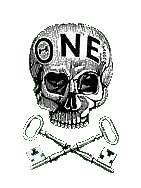Theta Nu Epsilon
| Theta Nu Epsilon | |
|---|---|
| ΘΝΕ | |
 |
|
| Founded | December 11, 1870 Wesleyan University |
| Colors | Green and Black |
| Headquarters | A national organization is maintained by the Alpha Chapter. |
Theta Nu Epsilon (ΘΝΕ, commonly known as T.N.E.) is a sophomore class society. Founded at Wesleyan University in 1870 as a chapter of Skull and Bones, the society accepts members regardless of their fraternity status.
Theta Nu Epsilon was founded on December 11, 1870 in Room Seven of Wesleyan’s South College by Herbert Hull Coston, Coleridge Allen Hart, George Washington Shonk, Lyman Horace Weeks, (all four Alpha Delta Phi), Benjamin Emmons Gerst, Arthur Collins McClay, George Bickford Davey Toy, (all four Delta Kappa Epsilon), Stephen Judson Kirby, George Henry Towle, Alfred Charles True, (all four Eclectic), George William Elliott, Charles Hamlin Furber, William Henry Lawrence, Olin Levings Livesey, (all four Psi Upsilon), Amos Howard Hoagland, (independent). Founded as the Wesleyan chapter of Skull & Bones, two years later the chapter cut its ties to Yale and changed the bones of the Skull & Bones emblem to keys.
Class societies were once common in northeastern American colleges and universities. There were freshman, sophomore, junior and senior class societies. Membership was by class year, and cut across the fraternity membership lines. Some class societies became fraternities outside the northeast; DKE and Alpha Sigma Phi were founded as class societies. Skull & Bones and Theta Nu Epsilon were probably the most famous and successful class societies.
T.N.E. is a sophomore class society, and in a traditional type chapter, members were chosen near the end of their freshman or start of their sophomore year. Once selected, the new members were active and responsible for operation of the chapter during their sophomore year. As juniors and seniors, they were considered honorary members and only had authority in an advisory role. The society always excluded freshmen. From the beginning, the identities of the sophomore members were kept secret. In yearbooks, the names of the sophomores appeared in code. The Alpha Chapter and legitimate chapters continue this traditional type. Several latter types of chapters developed over time: one type is that of the three-year society, adopted by chapters at many institutions without a class society system, a third type was as a feeder organization to a senior society, a fourth type was where the chapter acted as an interfraternity coordinating body, and a fifth type was as a wholly secret society, (which were usually chapters that had notorious reputations, such as the University of Alabama).
...
Wikipedia
